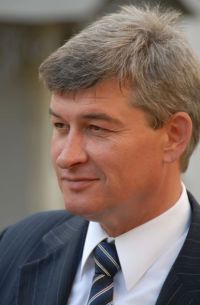
Dean of the Faculty RBEСS
prof. Shulga S.N.
Many graduates believe that the profession must choose once and for all, for life. And this point of view, of course, has a right to exist. However, it should be remembered that the priorities in life and in society is changing rapidly – it showed the last decade in our country. If the 1990s was prestigious to work as a lawyer or a financier (and this is confirmed by the size of the salary), the modern Ukrainian economy requires more specialists “materialized” trades – people with more knowledge engineering, the laws of nature. It is clear that in the current, dynamic world it is difficult to choose a profession “for life.” But people know that the world is eternal values. If people get in early life fundamental knowledge, it is throughout life will be in demand, it will be useful to society, he will always be offered a job with decent pay; about a man say: “He will never be lost!”. The fact that we have obtained the fundamental physical and mathematical education always lack the knowledge that in a short time to retrain and become a high professional in those occupations that are in demand at a particular stage of development of the national economy.
Training of specialists in radiophysicists KNU based on fundamental physical and mathematical education was started a hundred years ago (or more precisely, in 1911) with the coming to work in Kharkov University DA Rozhansky – student radio inventor – AS Popov. Current students of the Faculty of physics, biomedical electronics and computer systems are trained in the field of formation, storage, transmission, reception, processing and protection of various kinds of digital media (video, audio, control signals and telemetry), applied to the problems of communication, radar, navigation and telecommunications . The emphasis is on computer processing of signals. Scheduled training and in optoinformatics – section physics, associated with the creation of new materials, technologies and devices for transmitting, receiving, processing, storing and displaying information based on optical technology. (For example, without optoinformatics unthinkable modern Internet.) Currently at the Radiophysics Department develop research areas that are in demand all over the world – from biophysics (including electromagnetic biology) to digital (computer) physics, from biomedical electronics to the latest information technology, from microelectronics and nanoelectronics to space radio, microwave communications from physics to the electromagnetic environment.
There is no more exciting and challenging work than studying and mastering the fundamental laws of nature by means of electromagnetic waves, ie, through the use of radio-physical (non-contact, does not destroy the object of study) methods. For example, the use of magnetic resonance Radiophysical method allows you to get a detailed view of the internal organs of the human body (imaging) to determine the correct medical diagnosis, radio telescopes make it possible to obtain information about distant galaxies, the evolution of the universe. Using the appliance Quantum Radiophysics – laser makes it possible to successfully treat severe eye diseases – remove cataracts, glaucoma fight, to produce complex abdominal surgery without blood loss (lack of blood loss occurs because the cutting biological tissue, the laser beam at the same time “brew” the ends of tissue capillaries right and on the left of the cut line). Processing of electromagnetic waves of various solids and liquids substantially modifies their properties; so widely used in engineering, chemical, pharmaceutical, food industry, construction and electricity production and in other sectors of the economy. Radiophysical microwave devices are an integral part of modern accelerators of charged particles – of various types of cyclotrons and colliders, by which scientists reveal secrets of the microcosm. Radiophysical methods are capable of detecting near-Earth space objects the size of a tennis ball, and the same methods make it possible to create micro- and nanomotors for micro-robots capable of “targeted” to deliver the right medicine to a specific internal organs in need of treatment. Radiophysical methods are widely used in a variety of nanotechnology to create new materials with unprecedented early physical and chemical properties. All of the above provides a steady technological progress.
We are sincerely glad to see you not only as an undergraduate and graduate students, but also in the ranks of our future colleagues, opening with us the secrets of nature and working for the benefit and prosperity of our country.
Dean of the Faculty of Radiophysics, biomedical electronics and computer systems,
Professor, Doctor of Physical and Mathematical Sciences Shulga S.N.



